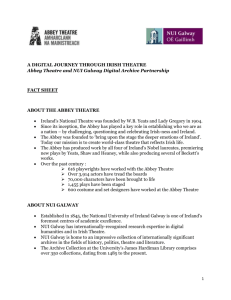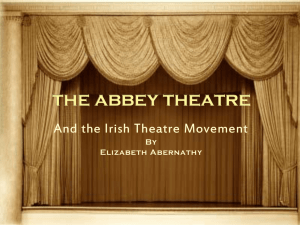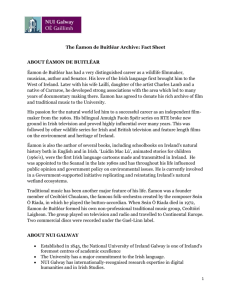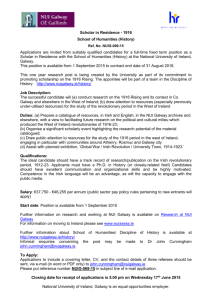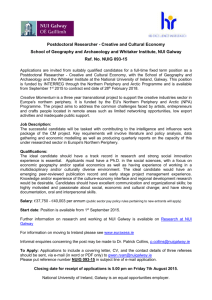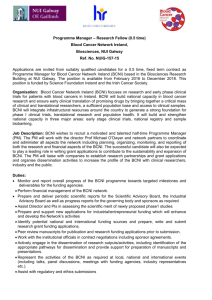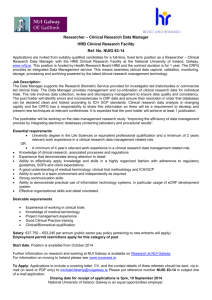NUI Galway President, Dr Jim Browne`s Speech
advertisement
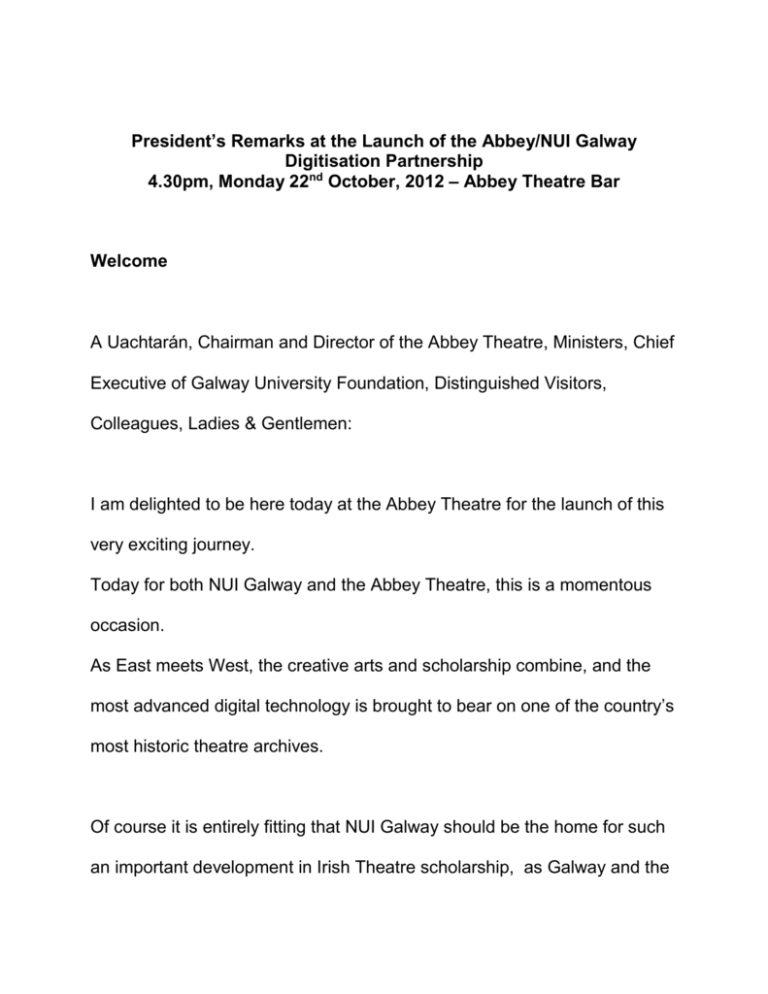
President’s Remarks at the Launch of the Abbey/NUI Galway Digitisation Partnership 4.30pm, Monday 22nd October, 2012 – Abbey Theatre Bar Welcome A Uachtarán, Chairman and Director of the Abbey Theatre, Ministers, Chief Executive of Galway University Foundation, Distinguished Visitors, Colleagues, Ladies & Gentlemen: I am delighted to be here today at the Abbey Theatre for the launch of this very exciting journey. Today for both NUI Galway and the Abbey Theatre, this is a momentous occasion. As East meets West, the creative arts and scholarship combine, and the most advanced digital technology is brought to bear on one of the country’s most historic theatre archives. Of course it is entirely fitting that NUI Galway should be the home for such an important development in Irish Theatre scholarship, as Galway and the West of Ireland is the birthplace of modern Irish drama – and the birthplace of the Abbey! It was in Galway in 1897 that Yeats, Edward Martyn and Lady Gregory first sat down to write their manifesto for the Irish Literary Theatre. Both Lady Gregory and Yeats had strong connections with Galway, as did that other great playboy of the western world, JM Synge. This great tradition for the creative arts in the West of Ireland continues to the present day with internationally-renowned playwrights like Tom Murphy and Thomas Kilroy, both deeply influenced by their connections with the West of Ireland. And there is also the Tony Award-winning Druid Theatre Company, which had its origins in the University – not to mention the many exciting young companies that have emerged in the City during the last decade. So this project to digitise the Abbey’s historic archive reinforces and celebrates that connection between Irish Theatre and the West, between Galway and the Abbey. Creativity This digitisation project is based on an awareness of the importance of the Abbey Theatre for the social, cultural and economic history of this country – not to mention its ongoing significance for Ireland and the international community as one of the key national theatres in the world. This project will mean that for the first time researchers will be able to view everything in the archive at the click of a button. This is an enormously exciting prospect and is likely to have a major impact on what we know about Irish drama and, by extension, Irish society and its development since 1904. As a full multimedia archive, the digital archive will provide researchers with access to the complete range of materials associated with theatre performance: not just the scripts but also the visual materials (costume, set, and lighting designs), sound materials (music scores, sound effects), and the supporting materials (adverts, press releases, reviews). It also makes available material about the productions – the work of important Irish actors such as Siobhan McKenna, Donal McCann, Liam Neeson, Gabriel Byrne, Fiona Shaw, and the many great actors who joined the Abbey company over the years. It will also tell the story about what happened behind the scenes, giving a unique insight into the business of the theatre. In short, this archive will revolutionise our understanding of Irish theatre. For NUI Galway the digital archive represents a tremendous resource for students and staff in the humanities. Students on our new undergraduate degree in Drama, Theatre and Performance will be able to learn about acting and directing by watching videos of great productions from the last 30 years from the largest video theatre archive in the country. Postgraduate students will be able to read scripts of major plays that helped to shape our country, before and after independence. A new PhD programme in Irish Drama, will encourage a new wave of young researchers from Ireland and abroad to come to Galway to learn about Yeats, Synge, Lady Gregory and the many other great writers associated with the Abbey. The digital Abbey archive will, of course, be a major addition to NUI Galway’s already impressive collection of literary archives. The Archive Collection at the University’s James Hardiman Library comprises over 350 collections, dating from 1485 to the present. Theatre collections include the papers of Thomas Kilroy and the Shields Family Collection and there is a particular focus on the archives of companies such as the Druid Theatre, Taibhdhearc na Gaillimhe and the Lyric Players Theatre in Belfast. A new Arts, Humanities and Social Sciences Research building will open at the heart of the campus in 2013, providing the perfect backdrop for this significant collection. Innovation The Abbey/NUI Galway Digitisation project is unique in that it highlights two of the most important features of contemporary Ireland: the richness of its cultural traditions and its capacity for technological innovation. It involves bringing the most advanced digital technology to bear on one of the country’s most historically significant archives in order to preserve that rich cultural resource for future generations. But also to open up access to the archive to researchers and students. Once complete, the archive itself will be one of the biggest digital archives ever created in the humanities. At 30 terrabytes it represents the size of 10,000 DVDs or 7 million songs on an MP3 player! It will require the development of new interfaces and will stimulate the development of new technologies. It will allow for new kinds of research. Archival research is by its nature arduous and time-consuming. By producing a fully-searchable database, NUI Galway will greatly increase the amount of work that is possible and will also allow for new links and correspondences to be discovered between previously unconnected material. NUI Galway is no stranger to such technological innovation as two of our largest research institutes boast international expertise in this field. The Moore Institute for the Humanities and Social Sciences has an international reputation for innovative and creative engagement with the arts and digital humanities, and is home to the largest digitisation project in the humanities in the EU, the TEXTE project. While our Digital Enterprise Research Institute (DERI) is the world’s largest research institute dedicated to internet technology-based research. Researchers at both of these institutes, together with archivists at our James Hardiman Library, will work together in dynamic multidisciplinary teams to ensure the very latest technology is used to illuminate the past. Conclusion Of course, this project is about much more than enhancing scholarship or making NUI Galway an international hub for the study of Irish Theatre. When Yeats and Gregory established the Irish Literary Theatre in 1897, their manifesto highlighted the importance of several key values. They wrote about the need for artists to have freedom to experiment. They argued that artists must challenge orthodoxies, must change the world not by being explicitly political but by being artistically daring. And they wrote too of the need for the artist to be rooted in a community. Those values remain relevant today – perhaps are more relevant now than they have been for many decades. And they are relevant not just for theatre-makers but for universities too. This project is about bringing the National Theatre and a National University together, and is rooted in those shared values, and in our joint determination to provide a service to the nation. This is about preserving a national treasure for the benefit of future generations and for helping all of us to understand better the country that we live in, and our place in the national story. The digital Archive will celebrate the Abbey Theatre as one of the world’s great national theatres, and Irish drama as one of the world’s great national traditions. The archive will protect its legacy and make it available much more widely than ever before. At NUI Galway we are proud of the role we will play in bringing this legacy to life for future generations. All that remains is for me to thank you, and, in particular, to thank President Higgins for joining us today at the start of this incredible journey.
